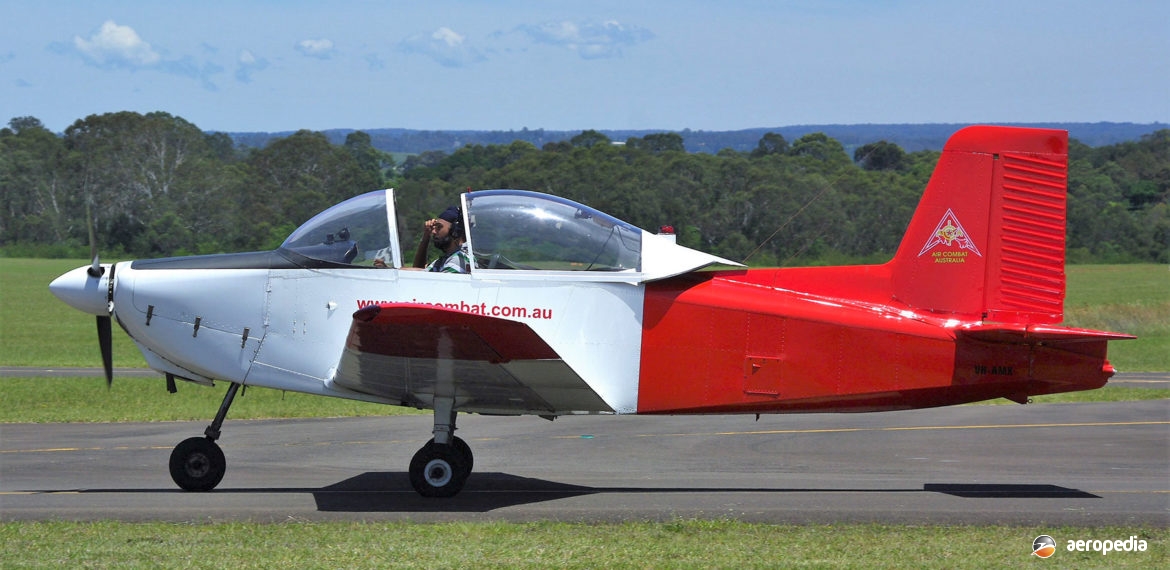Photograph:
AESL T.6-24 VH-AMX (ex NZ1760) taxiing at Camden, NSW in 2012 (David C Eyre)
Country of origin:
New Zealand
Description:
Two-seat touring and training monoplane
Power Plant:
One 112 kw (150 hp) Lycoming O-320-E2a four-cylinder horizontally-opposed air-cooled engine
Specifications:
- Wingspan: 8.15 m (26 ft 8 in)
- Length: 6.5 m (21 ft 5 in)
- Height: 2.10 m (6 ft 10 in)
- Wing area: 11.14 m² (120 sq ft)
- Max speed at sea level: 241 km/h (150 mph)
- Cruising speed at 1,219 m (4,000 ft) at 75% power: 233 km/h (145 mph)
- Cruising speed at 1,219 m (4,000 ft) at 65% power: 201 km/h (125 mph)
- Stalling speed: 89 km/h (55 mph)
- Service ceiling: 5,486 m (18,000 ft)
- Take-off distance to 15 m (50 ft): 390 m (1,280 ft)
- Landing distance from 15 m (50 ft): 396 m (1,300 ft)
- Empty weight: 533 kg (1,175 lb)
- Loaded weight [utility]: 794 kg (1,750 lb)
History:
Following the refusal of the Australian Federal Government to give preference to Australian-built aircraft and provide a tariff against imported aircraft, the Aviation Division of Victa Ltd ran into financial difficulties and production stopped after 168 Airtourer aircraft had been completed, although a further four aircraft were on the production line.
Rights to the design were sold to Aero Engine Services Ltd (AESL) of Hamilton, New Zealand (later New Zealand Aerospace Industries). This sale included two near complete aircraft (c/ns 169 and 170) and major components for another two (c/ns 171 and 172). The near complete aircraft were finished as Victa Airtourer 115s (ZK-COX and ZK-COY), and c/ns 171 and 172 became a new type, the AESL Airtourer 115, becoming ZK-COZ and ZK-CPA with new c/ns 501 and 502. AESL then continued development of the type to take more powerful engines, the first of these with a 112 kw (150 hp) unit becoming ZK-DBD (c/n 551).
This was followed by a new design aimed at the military training market, the AESL Airtourer T.1, the first of which ZK-CGN (c/n 556) had a 75 kw (100 hp) engine which was followed by the T.2 with the 86 kw (115 hp) engine, these being similar to the Victa 100 and 115. The T.3 had a Rolls Royce O-240 97 kw (130 hp) engine; the T.4 and T.5 both having 112 kw (150 hp) engines, the T.4 having a constant speed propeller and the T.5 having the constant speed propeller, optional electric flaps and trim, and some airframe strengthening in order to meet military training requirements.
In 1978 under the Colombo Plan the New Zealand Government had AESL build six T.6-24 Airtourers and gifted them to the Singapore Air Force for training air cadets. However, in 1983 they were placed into storage as the spare parts inventory could no longer be maintained. In March 1987 these six aircraft were sold and imported to Australia where they became VH-BVV (c/n B571), VH-FVV (c/n B570), VH-JVV (c/n B559), VH-LVV (c/n B573), VH-OVV (c/n B558) and VH-XVV (c/n B574).
AESL also built four T.6-24s for the RNZAF in 1976, these having a 119 kw (160 hp) engine with a constant speed propeller, electric flaps and electric trim, the Air Force testing an Airtourer 150 (ZK-CXS) in 1968. They were used as basic trainers at Wigram (serials NZ1760 to NZ1763). However, they were retired in 1993 and were replaced by the introduction into service of the CT-4 Airtrainer. They were sold. NZ 1760 (c/n A542 – ex ZK-JBX) became VH-AMX; NZ1761 (c/n A546) becoming ZK-LAD; NZ1762 (c/n A552) became ZK-JBZ but was damaged when it over-ran Reeve airfield on 8 January 1999; and NZ1763 became VH-MUM (c/n A553 – ex ZK-JAX) and after operating in Australia returned to New Zealand where it became ZK-WBW.
AESL also built the Airtourer in some numbers for civil use, a number being supplied in partly assembled form to Glos-Air Ltd at Staverton Airport in Gloucestershire, UK. At that time in the 1970s two models were available, the Airtourer 115 with an 86 kw (115 hp) Lycoming O-235 engine, and the Super 150 with a 112 kw (150 hp) Lycoming O-320 engine, with either a fixed-pitch or constant-speed propeller.
Flight magazine described the Super 150: “the machine makes a fine tourer – the cruise performance is above average in terms of speed and efficiency, thanks to the small wing, and the extra strength is a comfort should one happen to bump into rough weather en route” and “putting 150 hp, delivered through a constant-speed propeller, into a basic Airtrainer airframe produces a big step up in all-round performance and makes a very fine aerobatic performer of near contest standard.”
At least one Victa 100 VH-CTM (c/n 134) in Darwin, NT Australia has been converted to near T.6 specifications by using AESL drawings and installing a 119 kw (160 hp) fuel-injected engine and a constant speed propeller. Others have been converted to take 112 kw (150 hp) engines and became known as the Super 150. A couple has been modified with engines up to 134 kw (180 hp), and one fitted with a Lycoming AEIO-320 fuel-injected engine became known as the T.8.

